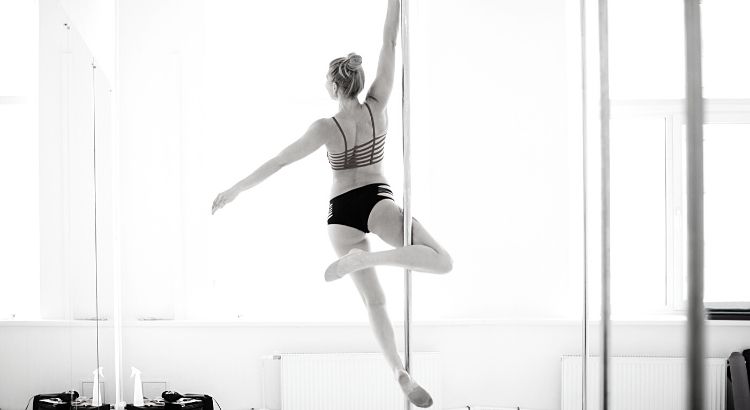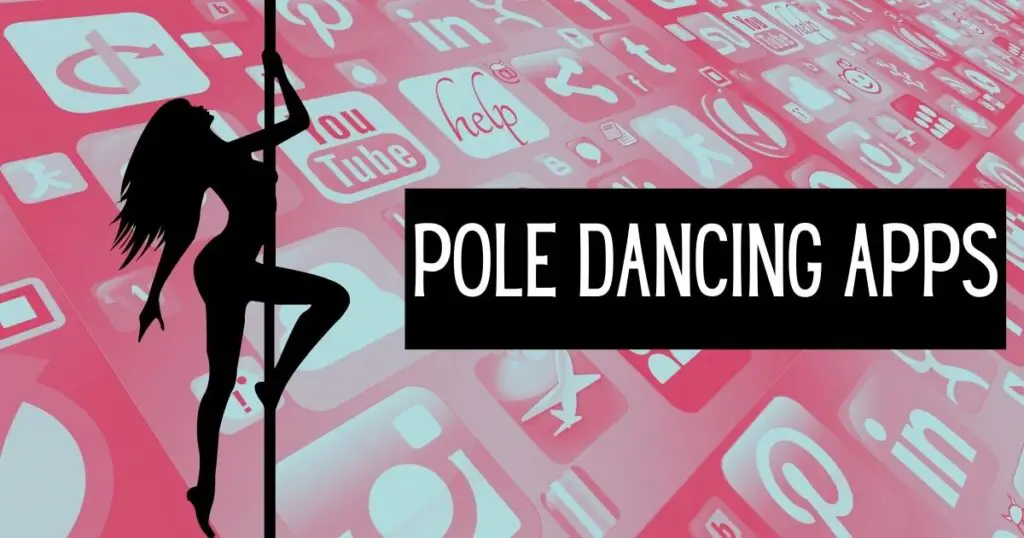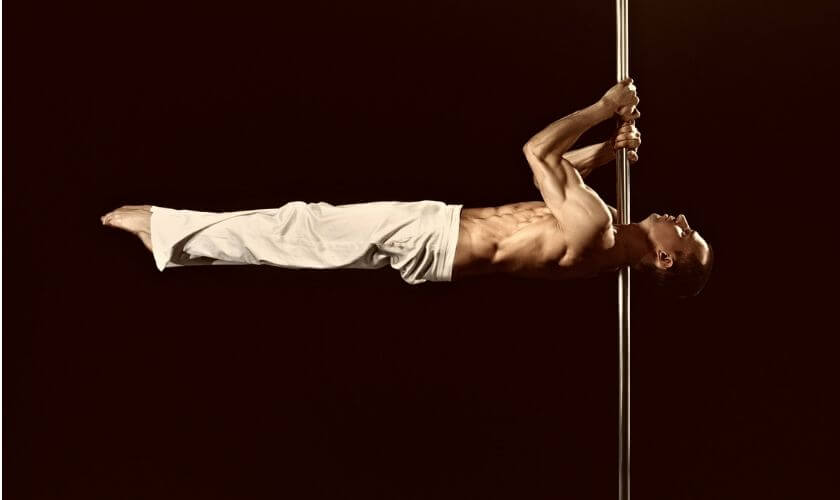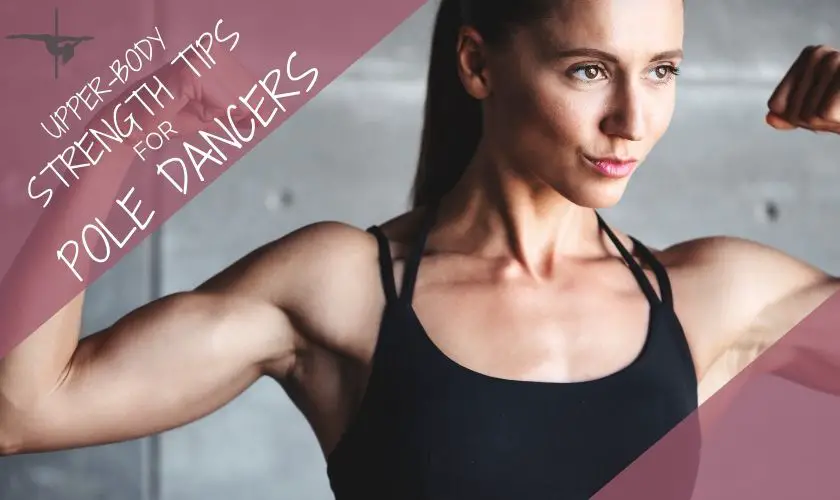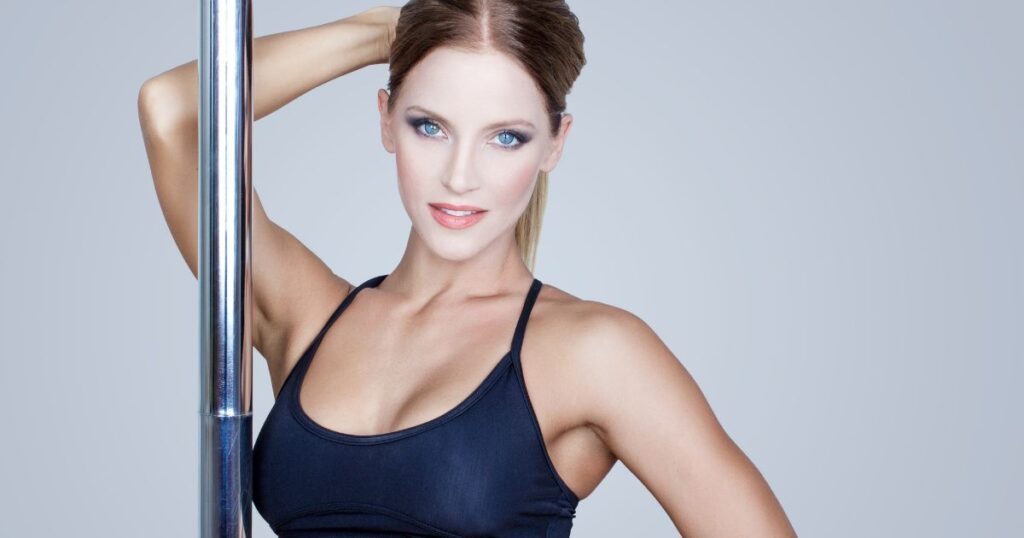So you’re thinking about trying pole dancing for the first time? That’s so exciting! Pole dancing can change the way you feel about your body forever – so we’ve written this handy guide covering all aspects of pole dancing – specifically for beginners!
Contents
- Pole Dancing Basics
- How Will Pole Dancing Affect Your Body?
- What To Expect At Your First Pole Class
- Other Ways to Learn Pole Dancing
- Want to become an amazing pole dancer?
- Basic Pole Fitness Moves for Beginners
- More Pole Dancing Tips for Beginners
- Pole Dancing Mistakes to Avoid
- Conclusion: Pole Dancing for Beginners
Now, I know starting anything new can be a little intimidating, especially something like pole dancing which is probably totally unlike anything you’ve tried before – but don’t worry!
Pole dancing is for everyone, regardless of age, size, or fitness level. It’s all about finding your own rhythm and having fun. However, confidence to take that first step by registering at your first pole class can be a barrier for many people.
This is exactly why we’ve put this guide together.
You will learn:
- The basics of pole dancing for fitness, fun and confidence
- How pole dancing will affect your body
- What to expect at your first class
- Alternative ways to learn pole dancing without attending a class
- An overview of some basic pole fitness moves for beginners
There’s a lot to learn about this incredible hobby – so I’ve broken it down into easy-to-understand sections for you to read through.
So, if you’re ready to give pole fitness a try, here’s what you need to know when you get started with pole dancing.
I started my pole fitness journey back in 2009 and I became an instructor in 2013. I set this website up as a resource for beginner pole dancers who are learning to pole dance.
Pole dancing completely changed my entire life. It changed the way I feel about myself and my body. I was amazed at what my body was capable of – you can experience this too!
Pole dancing is a truly inclusive sport – welcoming to everyone regardless of your size, height and weight.
Pole Dancing Basics
Modern pole dancing is a combination of different sports (some of which are over 800 years old!) and it’s generally considered to be a high-energy, full-body workout that requires strength, flexibility and endurance to complete gravity-defying tricks.
Pole dancing combines elements of:
- Gymnastics
- Ballet
- Aerial sports
- Contemporary dance
- Sensual movement
So a typical pole dancing performance, routine or lesson may consist of learning things like:
- Spinning on the pole
- Holding static positions on the pole
- Inverting on the pole
- Floorwork
- Choreography, rhythm and flow
- Warm-ups and cool-downs
- Stretches to improve flexibility
How Will Pole Dancing Affect Your Body?
Listen – when I started pole dancing I was totally weak. I couldn’t do a single pull-up. Not one.
Strength comes with time – this more often you practice – the stronger you’ll become. So, it’s completely OK if you don’t have any strength to begin with.
You won’t be expect to be inverting on your first class! Everyone has to start somewhere.
But, as a newbie pole dancer – here’s what you can expect:
1. You’ll Get Physically Stronger 💪
Pole dancing requires you to lift and hold your own body weight while making it look super easy.
The majority of pole dancing moves involve using your upper body muscles and core muscles in unison, so most pole dance instructors will encourage you to start conditioning your muscles to build strength straight away.
With regular pole dancing workouts, you’ll build your shoulder muscles, biceps, triceps and forearms.
As pole dancing moves don’t really target one particular muscle at a time, you’ll generally be working all of these muscles for each move, trick or transition you perform. That means you’re getting a complete workout, working multiple muscles at the same time.
Don’t worry if you don’t have a lot of upper body strength to start with, that’s fine! Most beginners will start attending pole classes with very little strength. But, do you know what? They become strong very fast and you will too.
Beginner pole moves that target your upper body:
- Front spin
- Climbing
- Lift & tuck
2. You Will Be More Flexible 🤸♀️
Pole dancers also enjoy the benefit of being more nimble and bendy. Being flexible reduces your risk of muscle injury and muscle soreness, as well as looking jawdroppingly-beautiful on the pole!
Pole dancers train their bodies to be able to bend into incredible shapes, and it really pays off. By attending regular pole fitness classes, you will soon find yourself being extra flexible!
Increased range-of-motion in your joints has a range of other health benefits, such as fewer aches and pains, more energy and confidence.
Beginner pole moves for flexibility:
- Splits on the floor, holding onto the pole for support
- Figurehead stretch (feet on floor)
- Floorwork
3. Stronger Bones 🦴
Pole dancing strengthens muscles, joints and connecting tissue.
During a pole session, you’ll put less stress on your joints than you would if you were running or doing an aerobics class. However, it’s still important to warm-up and cooldown properly to reduce injury.
The high-impact nature of pole dancing puts pressure on bones, which in turn stimulates growth and strengthens them.
This is why pole dancing is an excellent exercise for those looking to improve their bone health, especially as we age and our bones naturally become more fragile.
4. Burning Those Calories 🍕
Pole fitness students often ask me “Is pole dancing strength or cardio?”
Well… it’s actually both!
All forms of exercise will help you trim the excess fat. but, did you know that pole dancing can burn the same number of calories in 30 minutes as aerobics or callisthenics? Well, it’s true!
I’m sure many people feel as if they could lose a few pounds. Well, pole dancing is the perfect way to do it!
Pole dancing for fitness is a high impact sport that builds muscle and burns fat at the same time.
When you’re practising on the pole, you’re using a wide range of muscles, which, when used in unison will burn fat at the same time as making your muscles stronger.
This works in the same way as doing circuits or cross-training. Pole dancing combines cardiovascular activity with strength building for the ultimate workout.
Pole dancing is a full-body workout and works the muscles in a more intense way than many other forms of exercise.
What To Expect At Your First Pole Class
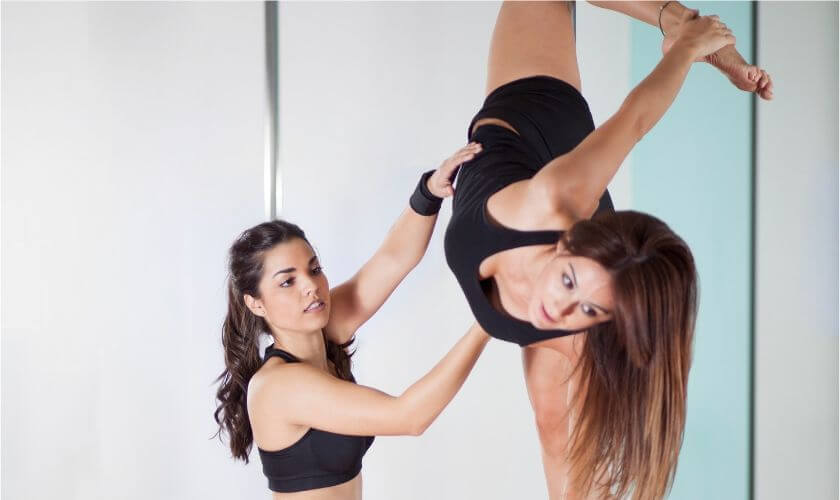
Most classes start with a warm-up, which may involve running, twisting, jumping jacks, burpees, lunges, light stretches and other techniques to warm your muscles up.
Your instructor will likely go through some strength-building techniques with you that incorporate the pole. These could be pull-ups, leg raises, side crunches and gentle stretching.
It’s OK if you can’t perform any of these exercises well at first, the whole point is to help you gain strength. You should try the exercises, even if they feel ‘impossible’ as it won’t be long until you find them simple!
You’ll also be taught some tricks and spins, most of which have names, which you don’t have to remember straight away!
It’s common to go over the same moves over and over again as a beginner, learning more with each attempt. Always listen to your instructor’s guidance.
The instructor will usually demonstrate the moves first, teach you the name of the trick, then break the trick down into stages and explain it to you. It’s important to listen to what they’re saying, it can be confusing when you first try a spin and you’re totally unsure about what to do with your leg – don’t get frustrated!
Afterwards, you’ll have a cool down, which will mean stretches both on and off the pole.
It’s common to feel a little bit beaten up after a pole dancing class, and you may also ache the next day, but that’s ok! It just means you’ve worked hard and your body is getting used to this new form of exercise!
Other Ways to Learn Pole Dancing
Learning to pole dance at home is ideal if you don’t have anywhere local offering pole fitness lessons.
First of all, you need to decide whether learning pole dancing at home is right for you. Consider your previous fitness experience, if you’re completely new to this form of exercise then you may benefit from attending a class, even if it’s just to learn the basics first.
In just a few lessons you can learn the basics with a qualified instructor by your side. It’s hugely beneficial if you can get a grasp of the basics, such as:
- Climbing the pole
- Different types of grip
- Sitting on the pole
- Spinning to the floor
- Basic invert techniques
Once you learn these techniques, then learning pole dancing at home is a great idea for you to save money on regular pole dance lessons.
You don’t have to completely nail all of these tricks, but you should have a good understanding of how to safely perform these techniques.
Once you’ve decided that learning pole dancing from home is right for you, then the next thing you’ll need is a pole to dance on! We’ve written multiple guides on this topic so to avoid repeating ourselves…
If you don’t yet know about portable dance poles, X Poles, and Freestanding dance poles then you can learn all you need to know from these articles
- Best Dance Poles (read this first)
- Portable Dance Pole Buyer’s Guide (read this if you have more questions)
- All You Need to Know About Freestanding Dance Poles (read this if you’re renting and can’t install a pole)
- Chrome, Brass, Titanium Gold, Stainless Steel, Silicone or Powder-Coated: Which Pole Finish is Right for you?
- X Pole XPERT “The Ultimate Dance Pole” Review (best spinning/static pole)
- X Pole Sport Review (best static only pole)
If you don’t have time to read all of that information right now, then what’s most important to know is that you choose a professional dance pole manufacturer such as X Pole or Lupit Pole and that you buy directly from them or from an authorized re-seller, such as Amazon.
Be very wary of fake X Poles being sold on eBay and Craigslist.

Online Pole Fitness Lessons
Believe it or not, one of the best ways to learn is with Online Pole Fitness Lessons.
Online lessons are perfect if you don’t have time to commit to a full course of pole dancing classes, or if there are no classes available in your local area.
Obviously, learning pole dancing online has a lack of real-time instruction and advice.
You may not realize that your technique may be completely wrong, but there’s no one there to correct you.
Repeatedly performing a move incorrectly can also lead to injuries and muscle strain over time, so try to seek advice from a professional instructor where ever possible and don’t attempt anything that doesn’t feel right.
There are some very high-quality online pole dancing lessons available right now, where the instructors go over each move in great detail, talk through technique and points of contact, explain common problems with different tricks and provide motivation through their instructions.
Online lessons are great once you already have a basic understanding of the foundational pole fitness tricks.
Want to become an amazing pole dancer?
Open Dance Academy has over 450 online lessons, by some world famous pole dancing champions! Join now to get:
***GET 10% OFF OPEN DANCE ACADEMY***
Use the code polefitfreedom to get 10% off Pole Dancing Lessons with Open Dance Academy. This is an exclusive offer for readers of this blog!
Basic Pole Fitness Moves for Beginners
Here are some moves and spins that you’re likely to learn within your first few pole lessons:
1. Walking Around the Pole
When walking around the pole, you need to pay attention to your body’s position in relation to the pole, as well as ensuring that your shoulders are rotated back and you maintain good posture.
The way that you walk is important too, walking on tip-toes or wearing high heel shoes (optional for beginners) will give your legs a killer workout, as well as make you look more elegant. Keep your toes pointed too!
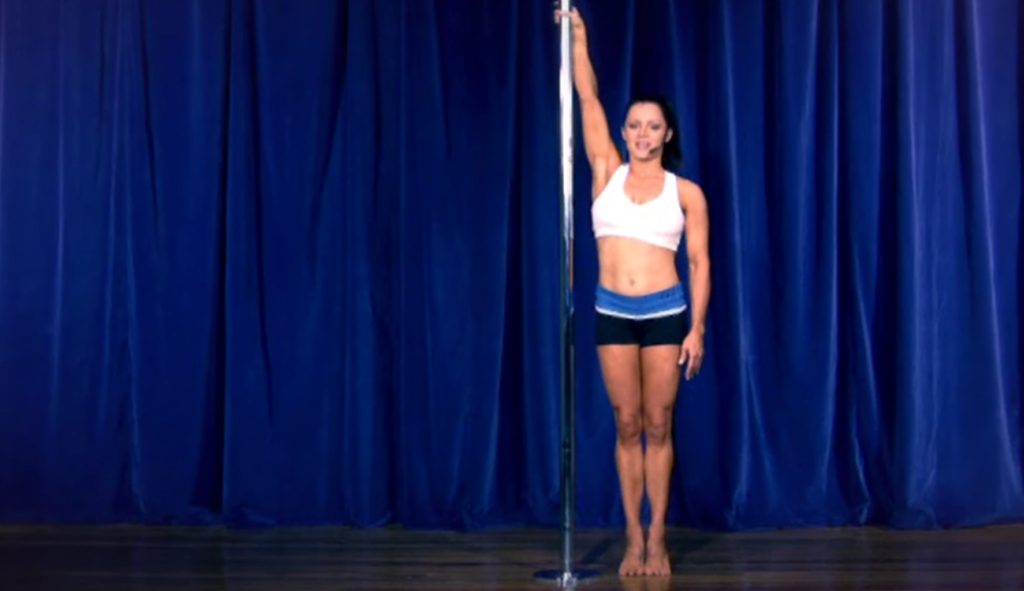
2. Sitting on the Pole
This is another staple move you’ll need to learn as a beginner.
It’s also a good way to start building up your pain threshold, as this move hurts – quite a lot!
You can introduce yourself to thigh-grip fairly quickly and in a controlled way, by sitting on the pole but still holding on with your hands, then you can slowly remove your hands as you build up grip strength.
This is another staple move for beginners to have in their repertoire. It’s also a good way to start building up your pain threshold, as this move hurts – quite a lot!
You can introduce yourself to thigh-grip fairly quickly and in a controlled way, by sitting on the pole but still holding on with your hands, then you can slowly remove your hands as you build up grip strength.
3. Fireman Spin
The fireman spin is a classic spin that beginners will likely learn in their first few lessons, it may even be your first ever spin! It’s a spin that looks elegant and is not too tricky to perform for beginners, which will give you confidence.
Remember to always practice spins on both sides of the pole so your arms get an equal workout!
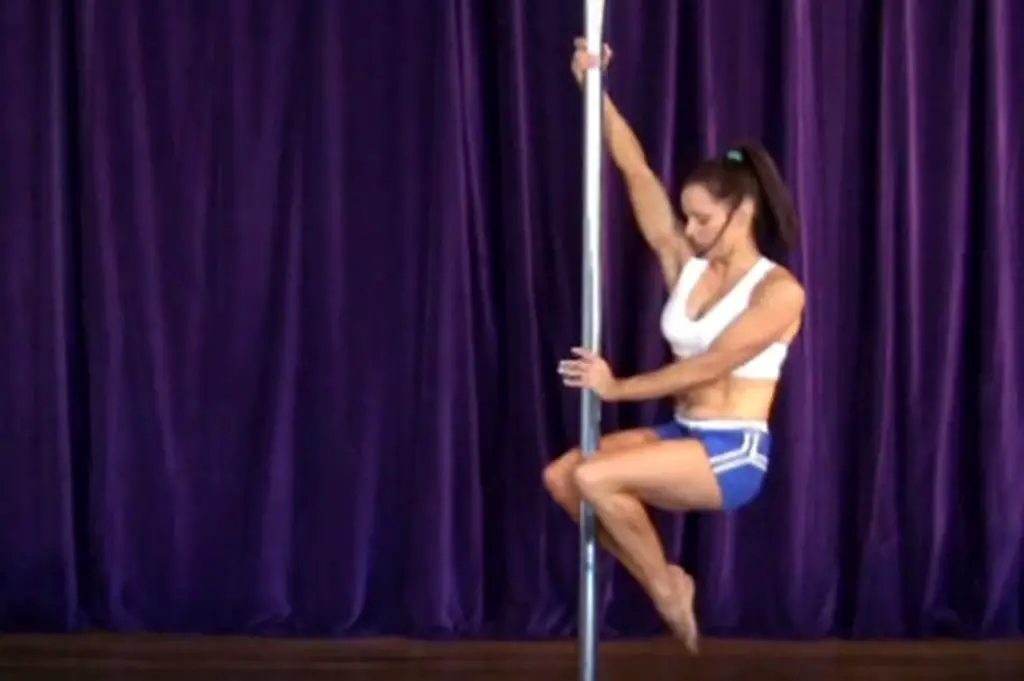
4. Split Grip Hold
Even though this move is suitable for beginners, it’s actually quite difficult, in fact it takes a lot of strength to lift yourself in this position. With split grip hold, your two hands are the only points of contact with the pole, your top arm is locked and your core is supporting your bottom arm.
It’s not expected for pole dancers to perform this trick right away, that’s because it takes practice more so than simply knowing the technique. It may take a few weeks of training to get this, but it’s important that you keep trying and don’t give up, as it’s important milestone for performing other more advanced and complex tricks.
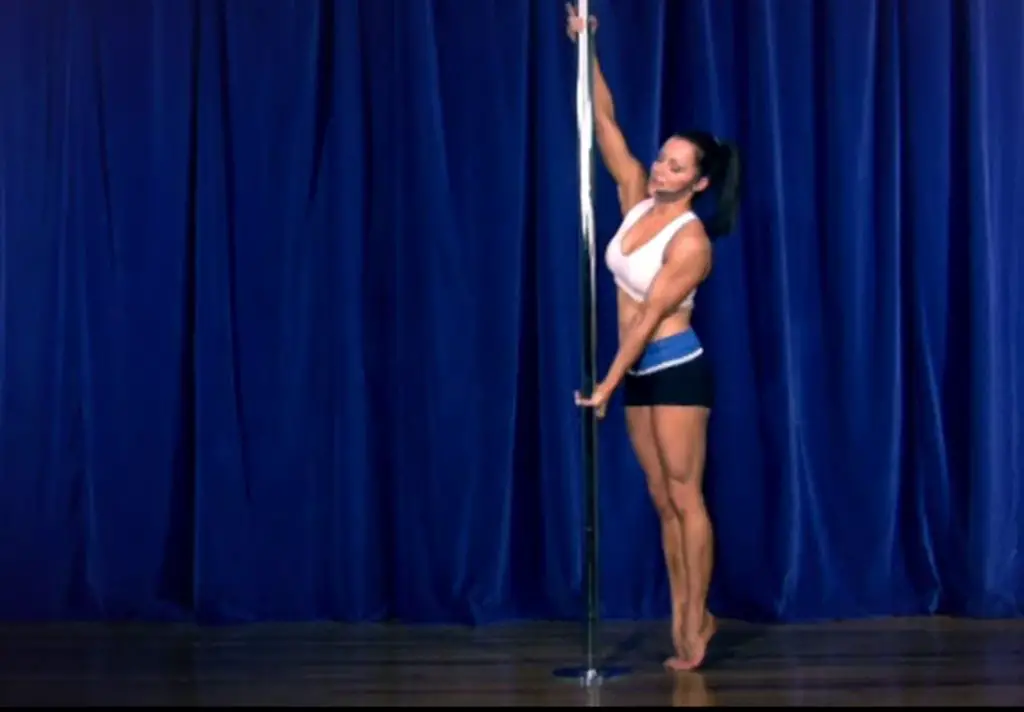
5. Floor work
As a beginner pole dancer, floor work is going to be an important part of your conditioning and routine preparation.
If you’re learning how to spin on a static pole, where you spin all the way down to the floor then this is a great opportunity to practice your floor work at the same time.
Some great examples of floor work are:
- Clockwork legs
- Bicycle legs
- Forward splits
- Box splits
- Hair flicks
- Slowly lower yourself into a push-up position
See also: When will I be able to invert?
More Pole Dancing Tips for Beginners
Phew! There’s more!
Bruising
Pole dancing bruises, friction burns and sore muscles are just some of the things that you’ll face along your pole journey. Many pole dancers even wear their bruises with pride, like badges of honor.
As an instructor, you can always tell from a student’s bruises what tricks they’re currently working on! You may hear bruises referred to by their less menacing name of “pole kisses!”
Sadly, a few knocks and scrapes are almost inevitable when you’re pole dancing.
This does get better with time, but bruises will always happen no matter your level!
Grip Aid Products
Grip aid products are essential for pole dancers – and they now come in about a million different varieties.
These include powders, liquids, antiperspirants, even gloves, kneepads and wrist protectors are available. Most pole dancers rely on grip aids during their performances and practice sessions. This is because pole dancing relies on friction and grip.

During the intense exercise of pole dancing, we get sweaty and that sweat affects our ability to grip properly. This is why pole dance grip aids are so widely used by beginners and professionals alike.
Whether you need a strong or mild antiperspirant, or a medium-strong grip product, there’s definitely something for you on this list! Depending on what your needs are, you’ll need a different type of grip.
So, we’ve wrote an entire guide about pole dancing grip products – read it here!
Safety
Safety is key when you’re doing any sport – the last thing you want is an injury.
Here are some safety tips for beginners getting started with pole dancing:
- Always warm-up and cool down Properly
- Check the stability of your pole
- Use a pole dancing crash mat
- Wear appropriate clothing
- Wash off any creams or lotion to reduce the risk of slipping
- Avoid wearing jewellery that could get tangled or caught
- Tie your long hair up and out of the way
What Should You Wear When Pole Dancing?
Here are some ideas about what to wear at your first pole dancing class:
- Yoga/Pole shorts (example)
- T-shirt or Vest top (example)
- Sports Bra (example)
- Knee-Pads for dancers – depending on what the floor is like at the class (example)
- Leggings – optional – for the warm-up (example)
When it comes to footwear, you can do a whole pole dancing class barefoot, if you want to. You may want to wear gym shoes for the warm-up if it involves jogging or jumping around.
If you want to wear 6-inch heels, such as Pleaser Shoes or Ellie Shoes, then check with your class instructor first. Some classes are done completely in heels, others are done barefoot, it’s usually the choice of the student what they choose to wear.
If you want some protection for your feet, but you ain’t into heels, then try yoga shoes!
What Not To Wear
- Loose shorts – when you open your legs you may flash the instructor if they’re too loose!
- Ultra-revealing outfits – as this is your first ever pole class, there’s no reason to show off, you’re there to focus on learning the technique and not to show off your breasts and booty to the other learners.
- A dress – a dress will either be too tight and restrictive or too loose and will get in the way of your tricks.
- Lotion/cream – wearing lotion or cream on your skin when pole dancing a major no-no! It can stop you from gripping the pole, so wash off any lotions before poling – for your own sake!
- Jewellery – this will scratch the pole and most likely get in the way.
Related: What not to wear when pole dancing
Pole Dancing Mistakes to Avoid
As a beginner pole dancer, you’re vulnerable to making some common mistakes and picking up bad habits early along your pole journey. This next section is about your lifestyle, habits and tips for beginner pole dancers to avoid the most common mistakes.
Mistake #1: Doing Too Much Too Soon
You’ll have probably already been inspired by the glamorous polers you see on Instagram and YouTube, but remember that these pole dancers have been practicing for years, and even they had to start somewhere. You can actually harm your own progress by doing too much too soon.
Of course, being adventurous is part of the fun of being a pole dancer, it’s what attracted you to the sport in the first place. You need to be adventurous to be a pole dancer, but too much adventure won’t help in the long run.
It’s very common for pole dancers to progress from ‘total beginner’ and suddenly think that they can fly. Don’t put pressure on yourself to suddenly shoulder mount when you’ve just learned to invert without assistance. It definitely won’t help your long-term progress.
There’s also the very real risk of injury. Don’t skip beginner-intermediate moves and head straight for the advanced stuff you see on Instagram or on YouTube. Learn to walk before you run.
If you do skip moves and go straight for the more adventurous tricks, you’re not allowing your muscles to build and adjust properly. You run a much higher risk or injuring yourself or pulling a muscle.
Also, just because you can perform a difficult trick, it doesn’t automatically means that less-difficult tricks are suddenly going to be simple for you to perform. All pole dancing tricks are impressive and they all need practice.
The best tricks are those that you perform with grace and by making it look effortless.
Mistake #2: Picking up Bad Form
As an instructor, there’s nothing more frustrating than seeing a student who has been ‘teaching themselves’ how to perform tricks with such bad habits, it’s unbelievable. With some tricks, there’s the correct way to do it, and the shortcut. Many ‘ self-taught’ pole dancers use the shortcut.
Patience is important. You may be able to jump into an invert, but you can gracefully lift yourself into it? Work on everything nice and slowly, paying attention to your placement and which muscle groups you’re engaging.
Bad form is something that’s very hard to change in the long-term, so ensure your technique is correct. Check with your instructor if you’re not sure about anything, or if something doesn’t feel right.
Related: Why Twisted Grip is Bad for You
Mistake #3: Not Believing in Yourself
You won’t believe how many pole dancers don’t come back for a second lesson because they think they “couldn’t do it” straight away. In their first lesson.
That’s an unbelievable lack of self-belief or a naive belief that pole dancing is somehow easy. It’s damn hard, guys! It’s also not normal to be great at pole dancing after 1 lesson, 5 lessons or even 50 lessons. Pole dancing is hard work but it pays off.
If you can’t do something straight away, that’s OK, you’re not supposed to be able to do it straight away! Otherwise, where’s the challenge?
Keep working on it, keep practicing and keep believing in yourself because you will be able to do whatever trick is giving you grief right now!
Mistake #4: Comparing Yourself to Others
Don’t. Just don’t. I was one of the slowest learners in the cohort of students I was part of. Everyone was quite literally and gracefully whizzing ahead of me while I was struggling with even holding myself off the ground for longer than half a second.
I was like an un-coordinated mash-up of arms and legs in the corner when everyone else was climbing to the top and high-fiving each other.
Of course, it’s natural to compare yourself to your peers, but please try to stop doing it. It doesn’t help your progress and only makes you feel disheartened.
Remember, there’s going to be a trick that you can perform with ease that becomes their nemesis move – just wait until you discover that trick 😉
Mistake #5: Skipping Warm-Ups & Cool Downs
This especially applies to those of you who have your own dance poles at home. It’s all too convenient just to jump onto the pole without properly warming up. Warming up your muscles is extremely important as it lowers the risk of injuries.
This is so easy to skip when you’re using your pole at home, but failing to warm up can result in injury and unnecessary muscle soreness, and no one wants that, do they?! Always make the effort to warm up before starting a pole session at home.
This doesn’t have to be as tedious as running on the spot for 5 minutes, why not have a quick run outdoors before starting your pole session? Or, use the stairs in your house to raise your heart rate for a few minutes if you’re running short of time.
It’s also important to warm up all your joints, especially your shoulders, wrists, hips, and knees. Your body is about to do a lot of serious work and we don’t want to cause premature wear-and-tear on our joints!
Warm-up stretching should be gentle and not too intense. The deep stretching should come after your pole session…
Related: A Simple 10-Minute Warm-Up for Pole Dancers
Mistake #6: Not eating a Balanced Diet
When you start a new fitness regime of any kind, having a healthy diet is the key to its success. If you’re eating a load of crap, then you won’t be noticing the changes in your body you were hoping to see.
Exercising isn’t like waving a magic wand that gives you the “excuse” to eat junk food. You need to maintain a healthy, balanced diet alongside your pole dancing workout regime if you want to see the physical results showing on your body.
You’ll get stronger and fitter if you practice pole fitness regularly, but you’ll get the body of your dreams if you eat well too. Eating well also means that your muscles will heal faster after a workout, you’ll feel less fatigued and it will improve your general overall well-being.
It’s a no-brainer really!
Conclusion: Pole Dancing for Beginners
Pole dancing is a fun and challenging workout that offers a full-body workout like no other.
This article has talked you thought the fundamental principles of pole dancing for fitness and learning how to pole dance.
The sooner you get started on your pole fitness journey, the sooner you’ll experience the many benefits of pole dancing for fitness, including building strength, improving flexibility, and increasing body confidence.
So what are you waiting for!?

